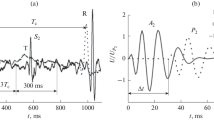Abstract
In a new approach to noninvasively diagnose coronary artery disease (CAD), auditory correlates attributed to blood flow turbulence have been associated with stenosed coronary arteries. These auditory components have been detected in diseased subjects by spectral estimation of diastolic heart sound recordings made on the surface of the chest. In this study, we investigated the dynamics of the process that produces these sounds in diseased subjects by applying the techniques of dimensional analysis. Our results indicate a difference in the “correlation dimension” between heart sounds of diseased and normal subjects. In particular, diseased subjects show a fractal dimension, implying the presence of a strange attractor and the possible existence of low-dimensional chaos in sounds associated with coronary artery disease.
Similar content being viewed by others
References
Akay, M.; Semmlow, J.L.; Welkowitz, W.; Bauer, M.; Kostis, J.B. Detection of coronary occlusions using autoregressive modeling of diastolic heart sounds. IEEE Trans. Biomed. Eng. 37:366–373; 1990.
Akay, M.; Semmlow, J.L.; Welkowitz, W.; Bauer, M.; Kostis, J.B. Non-invasive detection of coronary occlusions using eigenvector methods before and after angioplasty. IEEE Trans. Biomed. Eng. 37:1095–1106; 1991.
Albano, A.M.; Muench, J.; Schwartz, C.; Mees, A.I.; Rapp, P.E. Singular-value decomposition and the Grassberger Procaccia algorithm. Phys. Rev. 38(6):3017–3026; 1988.
Babloyantz, A.A. Destexhe Low dimensional chaos in an instance of epilepsy. Proc. Natl. Acad. Sci. USA 83:3513–3517; 1986.
Broomhead, D.S.; King, G.P. Extracting qualitative dynamics from experimental data. Physica 20D:217–236; 1986.
Duncan, G.W.; Gruber, J.O.; Dewey, C.F.; Meyers, G.S.; Lees, R.S. Evaluation of carotid stenosis by phonocardiography. New Engl. J. Med. 27:1124–1128; 1975.
Durand, L.-G.; Genest, J.; Guardo, R. Modeling of the transfer function of the heart-thorax acoustic system in dogs. IEEE Trans. Biomed. Eng. 32:592–601; 1985.
Frank, G.W.; Lookman, T.; Nerenberg, M.A.H.; Essex, C.; Lemieux, J.; Blume, W. Chaotic time series analyses of epileptic seizures. Physica D 46:427–438; 1990.
Fredburg, J.J. Pseudo-sound generation in atherosclerotic constrictions in arteries. Bull. Math. Biol. 36:143–155; 1974.
Grassberger, P.I. Procaccia. Measuring the strangeness of strange attractors. Physica, 9D:189–208; 1983.
Lees, R.S.; Myers, G.S. Noninvasive diagnosis of arterial disease. Adv. Intern. 24:475–509; 1982.
Lo, P.C.; Principe, J. The effect of filtering in the EEG correlation dimension estimation: experimental results. IEEE Engineering in Medicine and Biology Society 11th Annual International Conference, pp. 638–639, 1989.
Mayer-Kress, G.; Layne, S.P. Dimensionality of the Human Electroencephalogram. Annals New York Academy of Sciences, pp. 65–87, 1986.
Mayer-Kress, G.; Yates, F.E.; Benton, L.; Keidel, M.; Tirsch, W.; Poppl, S.J.; Geist, K. Dimensional analysis of nonlinear oscillations in brain, heart, and muscle. J. Math. Biosci. 90:155–182; 1988.
Padmanabhan, V.; Fischer, R.F.; Semmlow, J.L.; Welkowitz, W. High sensitivity PCG transducer for extended frequency applications. IEEE Engineering in Medicine and Biology Society 11th Annual International Conference, pp. 57–59, 1989.
Parker, T.S.; Chua, L.O. Practical Numerical Algorithms for Chaotic Systems. New York: Springer-Verlag, 1989.
Press, W.H.; Flannery, B.P.; Teukolsky, S.A.; Vetterling, W.T. Numerical Recipes, The Art of Scientific Computing Cambridge University Press, 1989.
Rapp, P.E.; Zimmerman, I.D. Experimental studies of chaotic neural behavior: Cellular activity and EEG signals. Nonlinear Oscillations in Biology and Chemistry. New York: Springer-Verlag, pp. 175–205, 1985.
Rosen, R.M.; Shakkottai, B.S.; Parthasarathy, P.; Turner, A.F.; Blankenhorn, D.H.; Roschke, E.J. Phonoangiography by autocorrelation. Circulation 55(4):626–633; 1977.
Ruelle, D. Small random perturbations of dynamical systems and the definition of attractors. Comm. Math. Phys. 82:137–151; 1971.
Semmlow, J.L.; Welkowitz, W.; Kostis, J.; MacKenzie, J.W. Coronary artery disease—correlates between diastolic auditory characteristics and coronary artery stenoses. IEEE Trans. Biomed. Eng. 30:136–139; 1983.
Skinner, J.E.; Goldberger, A.L.; Mayer-Kress, E.G. Raymond. Chaos in the heart: Implications for clinical cardiology. Biotechnology 8:1018–1024; 1990.
Webster, J.G. Medical Instrumentation, Application and Design. Boston: Houghton Mifflin Company, 1978.
Author information
Authors and Affiliations
Rights and permissions
About this article
Cite this article
Padmanabhan, V., Semmlow, J.L. Dynamical analysis of diastolic heart sounds associated with coronary artery disease. Ann Biomed Eng 22, 264–271 (1994). https://doi.org/10.1007/BF02368233
Received:
Revised:
Accepted:
Issue Date:
DOI: https://doi.org/10.1007/BF02368233




